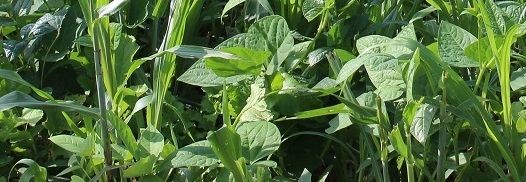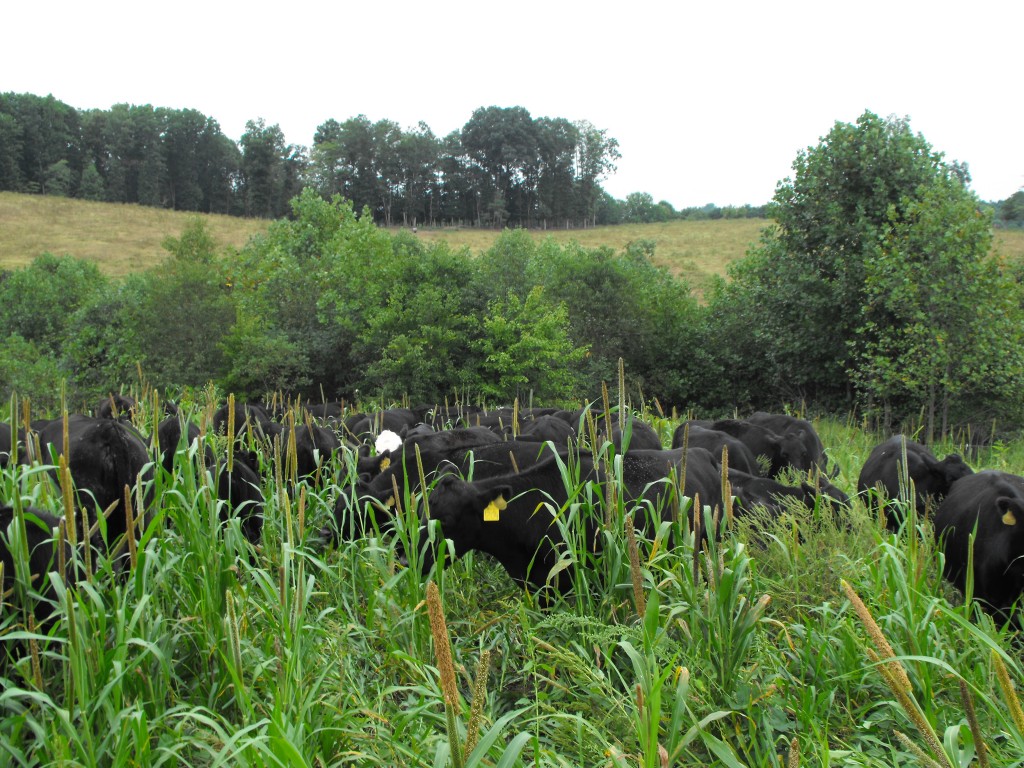
What if it’s a dry summer? Will cover crops tie up the soil moisture for your cash crop?
In most cover cropping scenarios, you will find the opposite. Unless you are using the cover crop in a manner that would normally be considered competitive with the main crop, such as growing the two simultaneously, cover crops instead will usually create long-term insurance against problems associated with drought. If you have interplanted a cover crop along with the main crop (rather than overseeding at a later point), both are establishing at the same time and the cover crop is likely to rob the main crop of nutrients, moisture, and maybe sunlight, depending on growth habit. In this situation, the cover crop behaves like a weed, instead of performing its desired functions before, after, or overlapped with the lifecycle of the cash crop. Recently our agronomists have had quite a bit of inquiry about this type of planting scenario, and we strongly discourage it!
Cover crops grown separately before the cash crop (and then terminated prior to the planting the primary crop, or shortly after the primary crop is planted into it “green”) are actually quite useful for retaining moisture in the soil. By keeping the soil surface covered and shaded, a cover crop lowers soil temperatures, reducing the amount of water that evaporates from the soil surface.
Cover crops have a longer term effect on soil too. By building soil organic matter and feeding a soil ecosystem’s microorganisms; they gradually improve the fertility, structure and moisture-holding capacity of that soil. This does not happen all at once, but will improve gradually with each year that a field is cover-cropped. Look at this as a long-term rather than a short-term investment.
Using grasses or including them in your cover crop mixes is an excellent way to build soil, as grasses have a higher carbon-to-nitrogen ratio than legumes and their residues take longer to break down, reducing erosion potential and eventually helping build soil organic matter. Many grasses also have deep, spreading fibrous root structures that can create channels in the soil and help deposit carbonaceous material at deeper levels. These roots also slowly contribute to breaking up plow pans: the organic material they deposit in the upper soil profile helps it hold more moisture before it gets saturated.
The most common summer annual grasses to plant in May or June are millet, sorghum-sudan, sudangrass, BMR tillering corn, and teff. These can be complemented in simple mixes with a legume like cowpeas or a brassica. In addition to improving soil, they suppress weeds and diversify the rotation, thwarting many pests. To put it another way, most of these summer annuals perform many of the classic cover crop roles of catch crop, smother crop, and break crop.
In the summer months, rain often comes in the form of storms, with an inch or more in a short time, interspersed with several weeks of dry weather. Cover crops are perfect for mitigating both of these problems, because they protect the soil surface from the heavy rainfall, and keep water in place instead of allowing surface runoff and erosion. They also help seal in moisture during dry times, acting as a living mulch and preventing the soil from heating up and becoming even drier. Bare soil can quickly turn into a feedback loop of hot-drier-hotter-drier. Summer cover crops can help buffer these summer weather extremes.
Winter cover crops likewise help soils dry out in the spring by taking up excess moisture as they break dormancy.
Year-round, cover crops also grow deep roots to scavenge and bring up nutrients, especially nitrogen, that are easily lost to leaching.
With each year of cover cropping, roots loosen the soil more and penetrate deeper, good news for both water percolation and breaking up compaction. Annual ryegrass roots are aggressive and grow deeper every season, helpful in rotation with corn. The corn roots can follow these channels to grow deeper in search of water. If the roots of past cover crops have been effective at breaking up plow pans or subsoil compaction, corn roots can grow down much deeper to get moisture. The ryegrass root and above-ground biomass also leaves organic matter in the soil, holding moisture and releasing nutrients as it decomposes.

Cover crops do need a certain amount of water to grow enough to do their job, however, otherwise it won’t be worth it to plant them. If there’s one time moisture is a critical consideration, it’s planting time through the strong establishment of the cover crop’s root system. You will need enough moisture at the proper planting depth for the seed to germinate, and we strongly recommend timing the seeding for when the planting zone is moist. If you are planting a cover crop or a mix that that contains a species with small seeds (such as teff, millet, clover, or brassica), this can be especially tricky, as small seeds must be planted shallow or they won’t germinate and emerge. A mix must be planted at a depth appropriate for its smallest species.
An extreme drought throughout the majority of the cover crop’s growth period will also interfere with producing a cover crop that can provide the needed soil benefits. Sorghums, sorghum-sudans, and sudangrasses have a somewhat unique ability to go dormant when weather becomes too dry for an extended time, but they, too, eventually need moisture to fuel growth and effective soil cover.
Plan to terminate cover crops earlier if a dry year is predicted, as well. This gives you a more flexible planting window to work with as you wait for moisture.
Cover crops add resiliency to a cropping system, and are extremely useful for protecting soil and building soil productivity, whether the summer turns out to be wet or dry. There are fears that cover crops use up soil moisture for the cash crop. This applies in some western U.S. cropping scenarios, but in the Northeast and mid-Atlantic you will likely find that the opposite is true. Cash crop fields that were previously cover-cropped almost always contain more soil moisture than fields that were fallow, and this is because they trap moisture – both by forming a physical barrier, and because they return moisture and moisture-holding organic matter to the soil when they are done growing.
Speak to an expert at King’s AgriSeeds now at 1-717-687-6224 or email us at [email protected].
